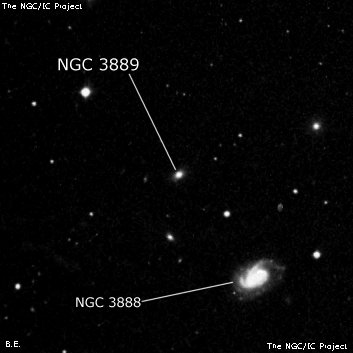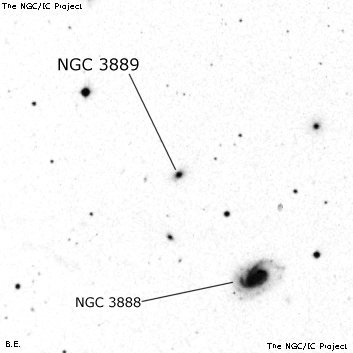NGC/IC Project Restoration Effort
(This is a very very beta version)
NGC3889


Basic Information
Location and Magnitude
Right Ascension: 11:47:48.1
Declination: +56:1:7
Constellation: UMA
Visual Magnitude: 14.8
Historic Information
Discoverer: Parsons L.
Year of discovery: 1878
Discovery aperture: 72.0
Observational
Summary description: vF, vS, 5' s of II 785
Sub-type: S0
Corwin's Notes
=====
NGC 3889. The NGC has this as 5' south of NGC 3888. This is incorrect; the
original observation by Lord Rosse in 1852 places the nebula 5' north of NGC
3888. Of the three galaxies there, I've taken the brightest as N3889.
[Note added June 1999: My old friend Tom DeMary has pointed out that the
brief explanation above might not be enough to cover the situation. Here is a
fuller story.]
Lord Rosse's original observation of NGC 3888 in 1852 has a second nebula five
arcmin north (he most likely saw the brightest of the three galaxies north and
northeast, so that is the one I've taken). In 1878, Dreyer revisited the
field, but found nothing to the north. Instead, he measured an object at a
position angle of 167.5 deg with a distance of 340.5 arcsec from N3888. It
was this measurement that led to the position and note in NGC for N3889.
Using the DSS position for NGC 3888, Dreyer's measurement reduces to
11 45 03.36, +56 09 09.3.
There is nothing at Dreyer's measured position. However, if he made a
transcription error in his distance -- read 240.5 for 340.5 -- then his
position falls close to a faint star (his position is 11 45 00.81,
+56 10 47.0 for B1950.0; the star is at [end figures only] 01.51 and 52.6).
It seems likely that this is the object that he measured and mistook as the
nebula seen by Lord Rosse.
Steve's Notes
=====
NGC 3889
18" (2/14/10): very faint, small, elongated 2:1 NW-SE, 24"x12", low even surface brightness. Located just 3.7' NE of NGC 3888. The redshift (z = .054) implies this is an outlying member of AGC 1377.
17.5" (3/19/88): very faint, very small, elongated WNW-ESE. Located 3.7' NE of NGC 3888.



